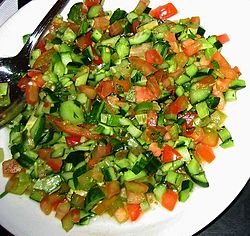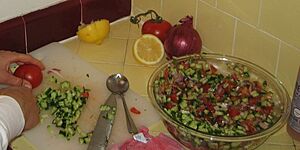Israeli salad facts for kids
 |
|
| Alternative names | salat katzutz (chopped salad), salat aravi (Arab salad), salat yerakot (vegetable salad) |
|---|---|
| Type | Salad |
| Main ingredients | Tomato, cucumber, onions, parsley, bell or chili peppers |
| Variations | spring onions, radish, carrot, cabbage, mint |
Israeli salad (Hebrew: סָלָט יְרָקוֹת יִשְׂרָאֵלִי, romanized: salat yerakot yisra'eli) is a fresh, chopped salad. It is made from finely diced tomatoes, onions, cucumbers, and bell or chili peppers. Many people consider it the most famous national dish of Israel. This salad is often served with almost every meal in Israel.
Similar chopped salads are very popular across the Eastern Mediterranean region. They might have different names but use almost the same ingredients. Jewish immigrants who moved to the Levant (the eastern Mediterranean area) in the late 1800s found this type of local salad. It became very popular in the kibbutzim, which were farming communities. Farmers there had plenty of fresh vegetables to use.
Outside of Israel, people usually call it Israeli Salad. But in Israel, it has other names. It is often called salat katzutz (Hebrew: סָלָט קָצוּץ), meaning "chopped salad." People also call it salat aravi (Hebrew: סָלָט עֲרָבִי), or "Arab salad," or salat yerakot (Hebrew: סָלָט יְרָקוֹת), which means "vegetable salad."
Contents
What is Israeli Salad?
Israeli salad is usually made with fresh, raw tomatoes, onions, and cucumbers. Sometimes, it also includes peppers, carrots, scallions (green onions), leafy greens, and parsley.
How is Israeli Salad Dressed?
The salad is typically dressed with fresh lemon juice or olive oil, or both. For breakfast, people often use Za'atar (a spice mix) and yogurt as dressings. For other meals, sumac (a tangy spice) and tahini (sesame paste) are common. The cucumbers are usually not peeled.
Serving Israeli Salad
In restaurants and cafes in Israel, this salad is served in many ways. It can be a side dish on its own. It also comes with main meals. You might find it stuffed inside a pita bread with falafel or shawarma.
Before breakfast cereals became popular, Israeli salad was a big part of traditional Israeli breakfasts at home. Today, it is still a common item at hotel breakfast buffets in Israel. Many families also continue to enjoy it at home.
History of Israeli Salad
Cucumbers have been grown in the Middle East for a very long time. However, tomatoes originally came from South America. They were not grown in the Syria region until the 1800s, during the time of the Ottoman Empire. In the 1940s, a kibbutz called Beit Alfa developed a special type of cucumber. This cucumber was named after the kibbutz and became the standard cucumber used in Israeli salad.
How the Salad Became Popular
Food historian Gil Marks explains that Jewish immigrants first saw this cucumber and tomato salad in Palestine in the late 1800s. At that time, Palestine was part of the Ottoman Empire. He believes the salad came from the Turkish çoban salatası (shepherd's salad). Both cucumbers and tomatoes were familiar vegetables to immigrants from Europe and the Middle East. Because of this, they quickly became a regular part of their diet.
The kibbutzim (farming communities) played a big role in making this salad popular. They often served a variety of salads and fresh vegetables for breakfast. As the salad became popular in the kibbutzim, it spread throughout all parts of Israeli cooking.
Variations of Israeli Salad
Different Jewish communities who moved to Israel have added their own touches to the basic recipe.
- For example, Jews from India might add finely chopped ginger and green chili peppers.
- North African Jews sometimes add preserved lemon peel and cayenne pepper.
- Bukharan Jews chop the vegetables very, very finely. They also use vinegar without oil in their dressing.
Discussion on Origins
Some people, like Israeli culinary journalist Gil Hovav, say that what is known as Israeli salad is actually a Palestinian Arab salad. Joseph Massad, a Palestinian professor, agrees. He sees it as an example of how Palestinian and Syrian foods, like hummus, falafel, and tabbouleh, have become known as "national dishes" of Israel.
Similar Salads Around the World
Many other places have salads similar to Israeli salad.
- Israeli Arabs or Palestinians might call their traditional cucumber and tomato salad salatat al-bandura or salatat banadura ("tomato salad"), or salata na'meh.
- In Persia, there is salad shirazi (سالاد شيرازي). This salad includes mint, diced onions, and peeled cucumbers.
- The Turkish çoban salatası is also very similar.
- Other similar salads are found throughout the eastern Mediterranean, including in Lebanon and Egypt.
- The Indian subcontinent also has a version of this salad called "kachumber".


